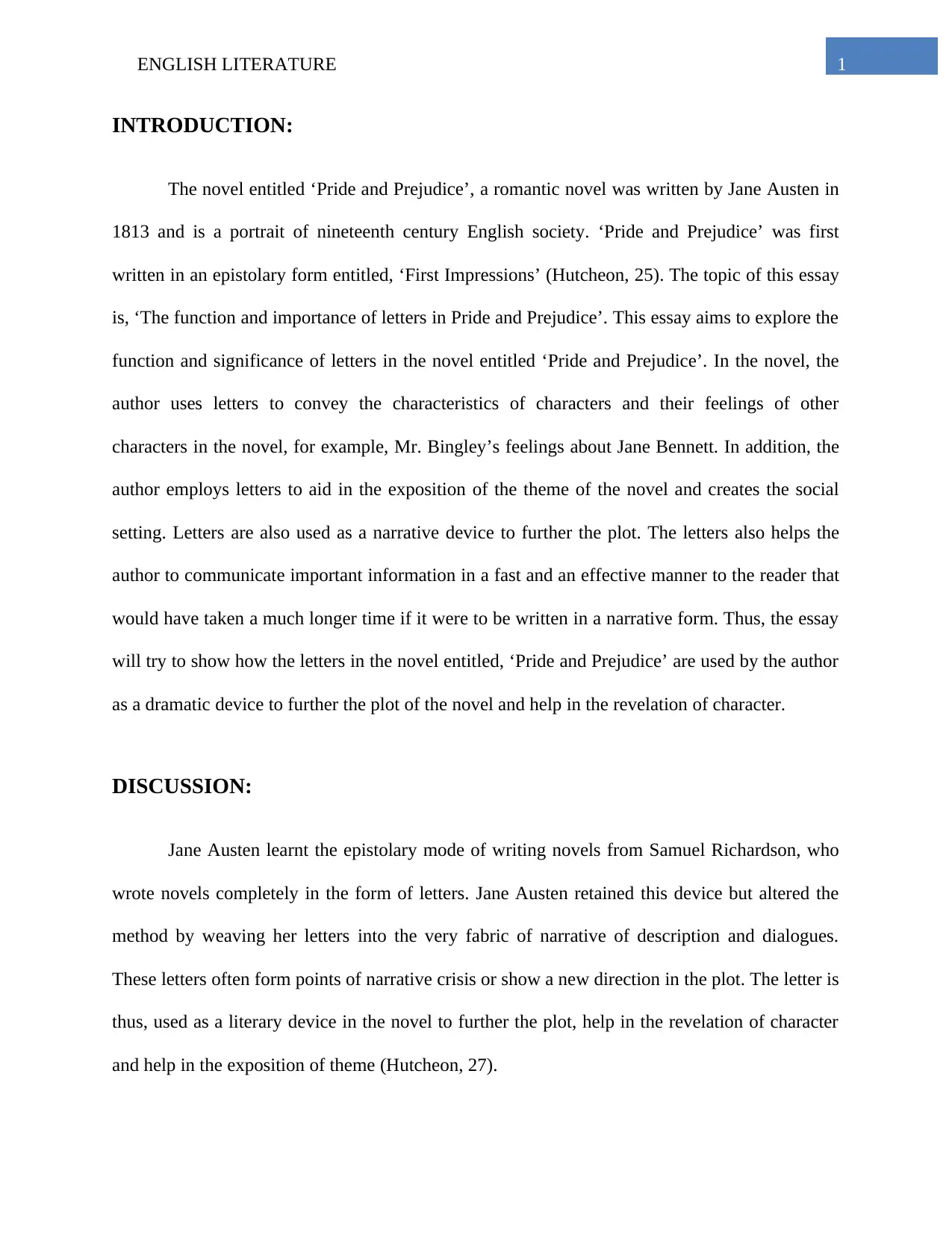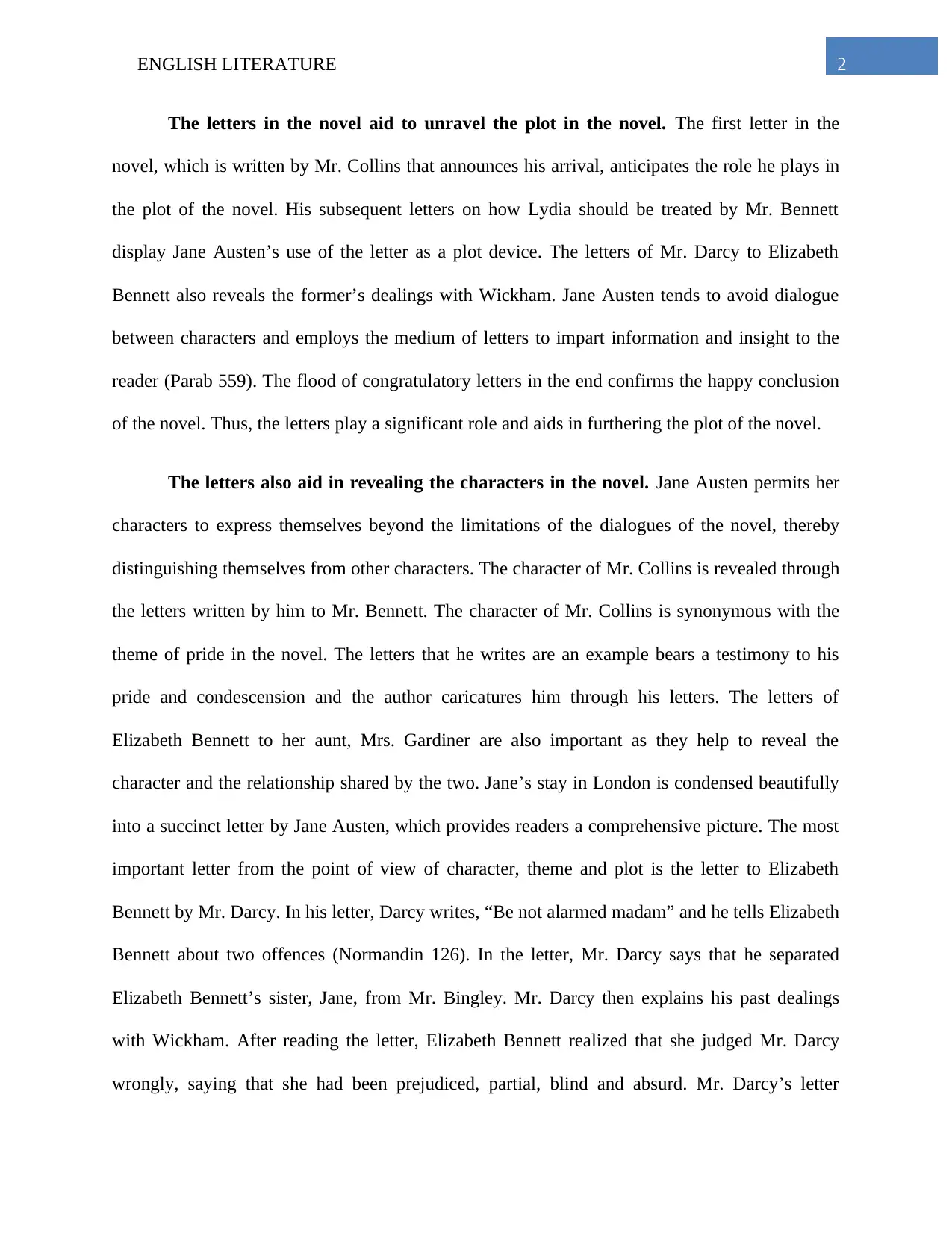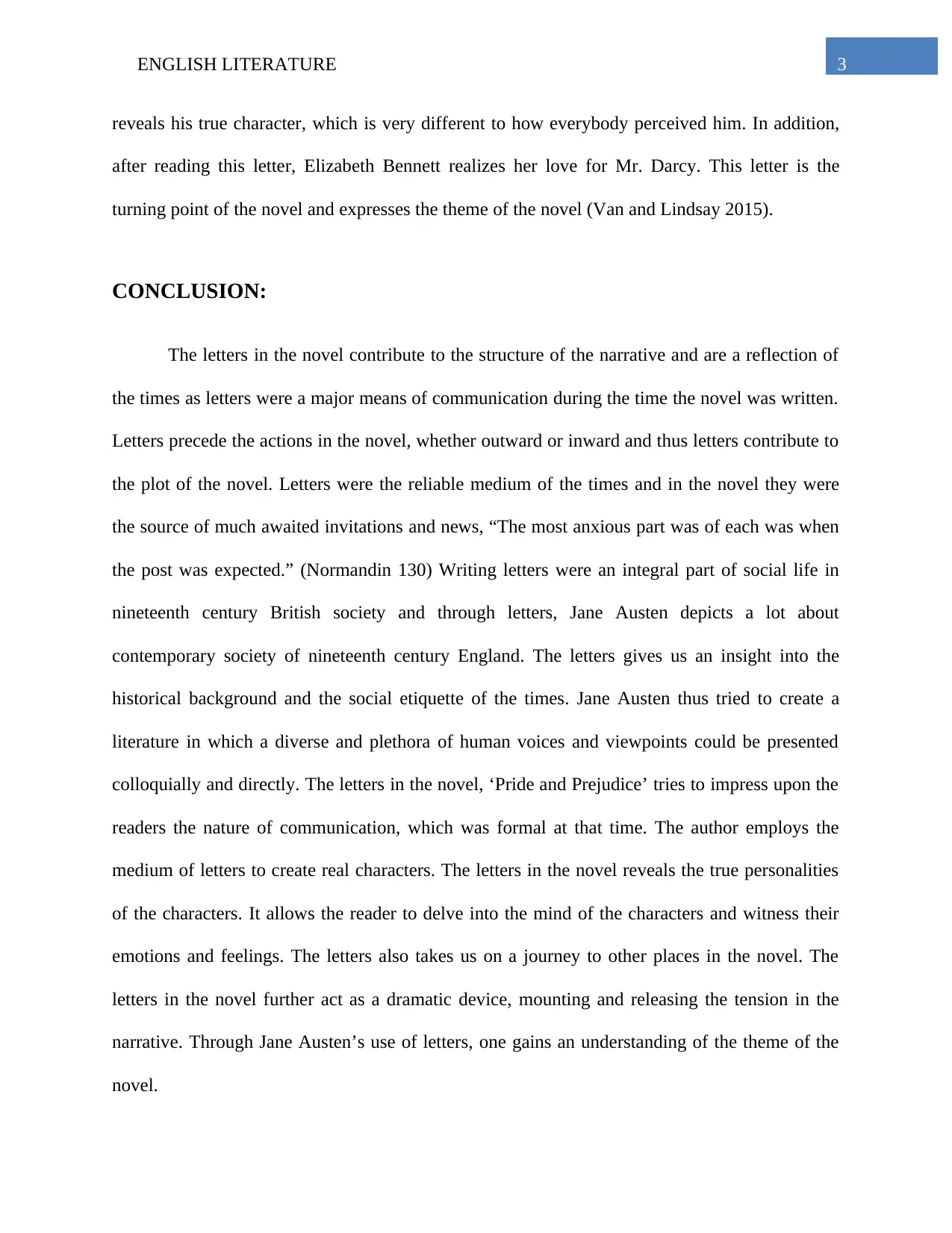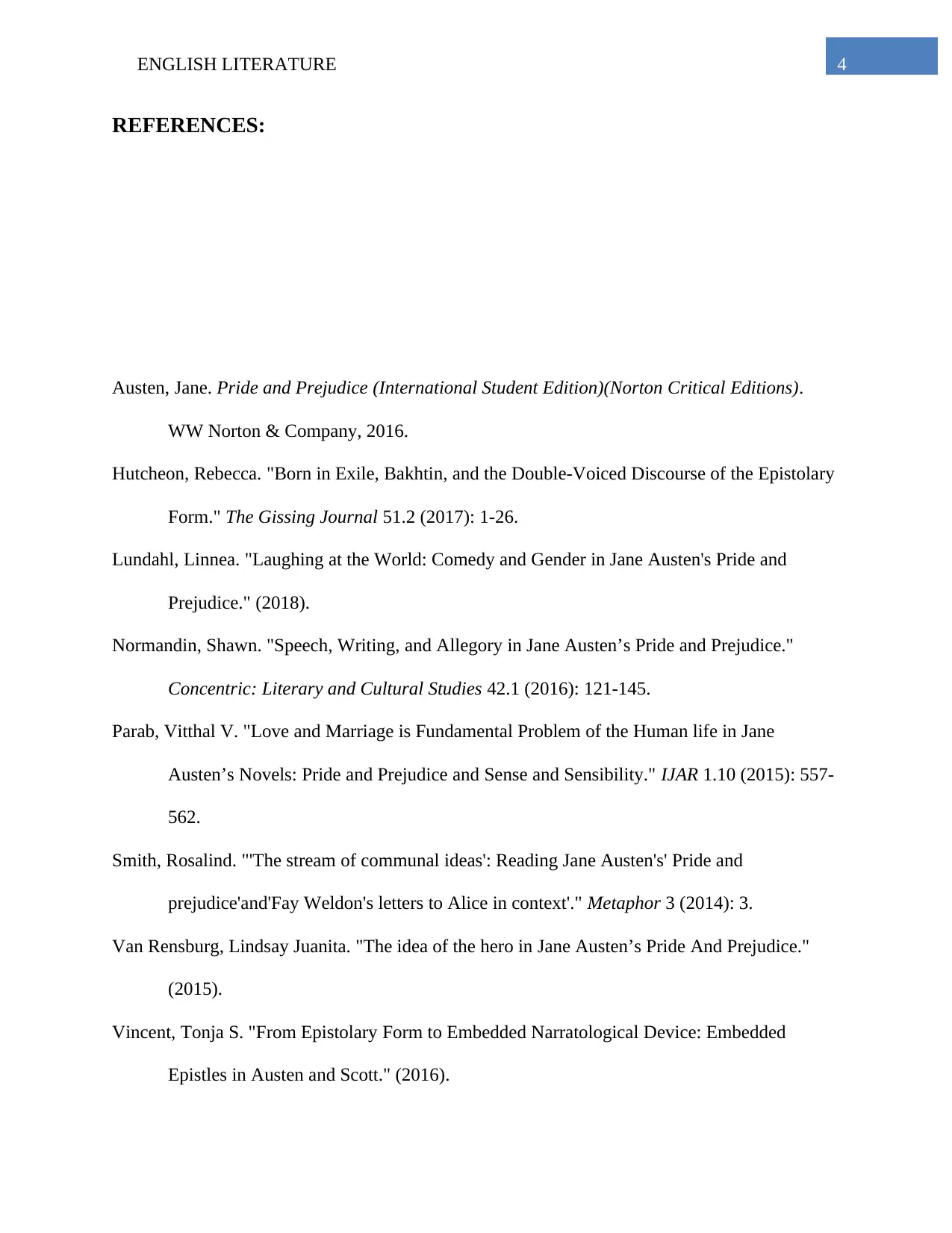Exploring the Role of Letters in Pride and Prejudice
VerifiedAdded on 2023/05/28
|5
|1405
|401
Essay
AI Summary
This essay delves into the function and significance of letters in Jane Austen's novel 'Pride and Prejudice,' highlighting how Austen employs letters as a dramatic device to advance the plot, reveal character, and expound on the novel's themes. Drawing inspiration from Samuel Richardson's epistolary style, Austen integrates letters into the narrative fabric, using them to create narrative crises and shift plot directions. The essay discusses how letters, such as those from Mr. Collins and Mr. Darcy, serve to reveal character traits, provide crucial information, and drive the storyline forward. Mr. Darcy's letter to Elizabeth Bennett is identified as a turning point, leading to Elizabeth's self-realization and the resolution of the novel's central conflict. Ultimately, the essay argues that letters in 'Pride and Prejudice' are not only a reflection of the 19th-century communication methods but also a key tool through which Austen crafts a rich portrayal of character, society, and the nuances of human interaction.

Running head: English Literature
English Literature
Name of the Student
Name of the University
Author Note
English Literature
Name of the Student
Name of the University
Author Note
Paraphrase This Document
Need a fresh take? Get an instant paraphrase of this document with our AI Paraphraser

1ENGLISH LITERATURE
INTRODUCTION:
The novel entitled ‘Pride and Prejudice’, a romantic novel was written by Jane Austen in
1813 and is a portrait of nineteenth century English society. ‘Pride and Prejudice’ was first
written in an epistolary form entitled, ‘First Impressions’ (Hutcheon, 25). The topic of this essay
is, ‘The function and importance of letters in Pride and Prejudice’. This essay aims to explore the
function and significance of letters in the novel entitled ‘Pride and Prejudice’. In the novel, the
author uses letters to convey the characteristics of characters and their feelings of other
characters in the novel, for example, Mr. Bingley’s feelings about Jane Bennett. In addition, the
author employs letters to aid in the exposition of the theme of the novel and creates the social
setting. Letters are also used as a narrative device to further the plot. The letters also helps the
author to communicate important information in a fast and an effective manner to the reader that
would have taken a much longer time if it were to be written in a narrative form. Thus, the essay
will try to show how the letters in the novel entitled, ‘Pride and Prejudice’ are used by the author
as a dramatic device to further the plot of the novel and help in the revelation of character.
DISCUSSION:
Jane Austen learnt the epistolary mode of writing novels from Samuel Richardson, who
wrote novels completely in the form of letters. Jane Austen retained this device but altered the
method by weaving her letters into the very fabric of narrative of description and dialogues.
These letters often form points of narrative crisis or show a new direction in the plot. The letter is
thus, used as a literary device in the novel to further the plot, help in the revelation of character
and help in the exposition of theme (Hutcheon, 27).
INTRODUCTION:
The novel entitled ‘Pride and Prejudice’, a romantic novel was written by Jane Austen in
1813 and is a portrait of nineteenth century English society. ‘Pride and Prejudice’ was first
written in an epistolary form entitled, ‘First Impressions’ (Hutcheon, 25). The topic of this essay
is, ‘The function and importance of letters in Pride and Prejudice’. This essay aims to explore the
function and significance of letters in the novel entitled ‘Pride and Prejudice’. In the novel, the
author uses letters to convey the characteristics of characters and their feelings of other
characters in the novel, for example, Mr. Bingley’s feelings about Jane Bennett. In addition, the
author employs letters to aid in the exposition of the theme of the novel and creates the social
setting. Letters are also used as a narrative device to further the plot. The letters also helps the
author to communicate important information in a fast and an effective manner to the reader that
would have taken a much longer time if it were to be written in a narrative form. Thus, the essay
will try to show how the letters in the novel entitled, ‘Pride and Prejudice’ are used by the author
as a dramatic device to further the plot of the novel and help in the revelation of character.
DISCUSSION:
Jane Austen learnt the epistolary mode of writing novels from Samuel Richardson, who
wrote novels completely in the form of letters. Jane Austen retained this device but altered the
method by weaving her letters into the very fabric of narrative of description and dialogues.
These letters often form points of narrative crisis or show a new direction in the plot. The letter is
thus, used as a literary device in the novel to further the plot, help in the revelation of character
and help in the exposition of theme (Hutcheon, 27).

2ENGLISH LITERATURE
The letters in the novel aid to unravel the plot in the novel. The first letter in the
novel, which is written by Mr. Collins that announces his arrival, anticipates the role he plays in
the plot of the novel. His subsequent letters on how Lydia should be treated by Mr. Bennett
display Jane Austen’s use of the letter as a plot device. The letters of Mr. Darcy to Elizabeth
Bennett also reveals the former’s dealings with Wickham. Jane Austen tends to avoid dialogue
between characters and employs the medium of letters to impart information and insight to the
reader (Parab 559). The flood of congratulatory letters in the end confirms the happy conclusion
of the novel. Thus, the letters play a significant role and aids in furthering the plot of the novel.
The letters also aid in revealing the characters in the novel. Jane Austen permits her
characters to express themselves beyond the limitations of the dialogues of the novel, thereby
distinguishing themselves from other characters. The character of Mr. Collins is revealed through
the letters written by him to Mr. Bennett. The character of Mr. Collins is synonymous with the
theme of pride in the novel. The letters that he writes are an example bears a testimony to his
pride and condescension and the author caricatures him through his letters. The letters of
Elizabeth Bennett to her aunt, Mrs. Gardiner are also important as they help to reveal the
character and the relationship shared by the two. Jane’s stay in London is condensed beautifully
into a succinct letter by Jane Austen, which provides readers a comprehensive picture. The most
important letter from the point of view of character, theme and plot is the letter to Elizabeth
Bennett by Mr. Darcy. In his letter, Darcy writes, “Be not alarmed madam” and he tells Elizabeth
Bennett about two offences (Normandin 126). In the letter, Mr. Darcy says that he separated
Elizabeth Bennett’s sister, Jane, from Mr. Bingley. Mr. Darcy then explains his past dealings
with Wickham. After reading the letter, Elizabeth Bennett realized that she judged Mr. Darcy
wrongly, saying that she had been prejudiced, partial, blind and absurd. Mr. Darcy’s letter
The letters in the novel aid to unravel the plot in the novel. The first letter in the
novel, which is written by Mr. Collins that announces his arrival, anticipates the role he plays in
the plot of the novel. His subsequent letters on how Lydia should be treated by Mr. Bennett
display Jane Austen’s use of the letter as a plot device. The letters of Mr. Darcy to Elizabeth
Bennett also reveals the former’s dealings with Wickham. Jane Austen tends to avoid dialogue
between characters and employs the medium of letters to impart information and insight to the
reader (Parab 559). The flood of congratulatory letters in the end confirms the happy conclusion
of the novel. Thus, the letters play a significant role and aids in furthering the plot of the novel.
The letters also aid in revealing the characters in the novel. Jane Austen permits her
characters to express themselves beyond the limitations of the dialogues of the novel, thereby
distinguishing themselves from other characters. The character of Mr. Collins is revealed through
the letters written by him to Mr. Bennett. The character of Mr. Collins is synonymous with the
theme of pride in the novel. The letters that he writes are an example bears a testimony to his
pride and condescension and the author caricatures him through his letters. The letters of
Elizabeth Bennett to her aunt, Mrs. Gardiner are also important as they help to reveal the
character and the relationship shared by the two. Jane’s stay in London is condensed beautifully
into a succinct letter by Jane Austen, which provides readers a comprehensive picture. The most
important letter from the point of view of character, theme and plot is the letter to Elizabeth
Bennett by Mr. Darcy. In his letter, Darcy writes, “Be not alarmed madam” and he tells Elizabeth
Bennett about two offences (Normandin 126). In the letter, Mr. Darcy says that he separated
Elizabeth Bennett’s sister, Jane, from Mr. Bingley. Mr. Darcy then explains his past dealings
with Wickham. After reading the letter, Elizabeth Bennett realized that she judged Mr. Darcy
wrongly, saying that she had been prejudiced, partial, blind and absurd. Mr. Darcy’s letter
⊘ This is a preview!⊘
Do you want full access?
Subscribe today to unlock all pages.

Trusted by 1+ million students worldwide

3ENGLISH LITERATURE
reveals his true character, which is very different to how everybody perceived him. In addition,
after reading this letter, Elizabeth Bennett realizes her love for Mr. Darcy. This letter is the
turning point of the novel and expresses the theme of the novel (Van and Lindsay 2015).
CONCLUSION:
The letters in the novel contribute to the structure of the narrative and are a reflection of
the times as letters were a major means of communication during the time the novel was written.
Letters precede the actions in the novel, whether outward or inward and thus letters contribute to
the plot of the novel. Letters were the reliable medium of the times and in the novel they were
the source of much awaited invitations and news, “The most anxious part was of each was when
the post was expected.” (Normandin 130) Writing letters were an integral part of social life in
nineteenth century British society and through letters, Jane Austen depicts a lot about
contemporary society of nineteenth century England. The letters gives us an insight into the
historical background and the social etiquette of the times. Jane Austen thus tried to create a
literature in which a diverse and plethora of human voices and viewpoints could be presented
colloquially and directly. The letters in the novel, ‘Pride and Prejudice’ tries to impress upon the
readers the nature of communication, which was formal at that time. The author employs the
medium of letters to create real characters. The letters in the novel reveals the true personalities
of the characters. It allows the reader to delve into the mind of the characters and witness their
emotions and feelings. The letters also takes us on a journey to other places in the novel. The
letters in the novel further act as a dramatic device, mounting and releasing the tension in the
narrative. Through Jane Austen’s use of letters, one gains an understanding of the theme of the
novel.
reveals his true character, which is very different to how everybody perceived him. In addition,
after reading this letter, Elizabeth Bennett realizes her love for Mr. Darcy. This letter is the
turning point of the novel and expresses the theme of the novel (Van and Lindsay 2015).
CONCLUSION:
The letters in the novel contribute to the structure of the narrative and are a reflection of
the times as letters were a major means of communication during the time the novel was written.
Letters precede the actions in the novel, whether outward or inward and thus letters contribute to
the plot of the novel. Letters were the reliable medium of the times and in the novel they were
the source of much awaited invitations and news, “The most anxious part was of each was when
the post was expected.” (Normandin 130) Writing letters were an integral part of social life in
nineteenth century British society and through letters, Jane Austen depicts a lot about
contemporary society of nineteenth century England. The letters gives us an insight into the
historical background and the social etiquette of the times. Jane Austen thus tried to create a
literature in which a diverse and plethora of human voices and viewpoints could be presented
colloquially and directly. The letters in the novel, ‘Pride and Prejudice’ tries to impress upon the
readers the nature of communication, which was formal at that time. The author employs the
medium of letters to create real characters. The letters in the novel reveals the true personalities
of the characters. It allows the reader to delve into the mind of the characters and witness their
emotions and feelings. The letters also takes us on a journey to other places in the novel. The
letters in the novel further act as a dramatic device, mounting and releasing the tension in the
narrative. Through Jane Austen’s use of letters, one gains an understanding of the theme of the
novel.
Paraphrase This Document
Need a fresh take? Get an instant paraphrase of this document with our AI Paraphraser

4ENGLISH LITERATURE
REFERENCES:
Austen, Jane. Pride and Prejudice (International Student Edition)(Norton Critical Editions).
WW Norton & Company, 2016.
Hutcheon, Rebecca. "Born in Exile, Bakhtin, and the Double-Voiced Discourse of the Epistolary
Form." The Gissing Journal 51.2 (2017): 1-26.
Lundahl, Linnea. "Laughing at the World: Comedy and Gender in Jane Austen's Pride and
Prejudice." (2018).
Normandin, Shawn. "Speech, Writing, and Allegory in Jane Austen’s Pride and Prejudice."
Concentric: Literary and Cultural Studies 42.1 (2016): 121-145.
Parab, Vitthal V. "Love and Marriage is Fundamental Problem of the Human life in Jane
Austen’s Novels: Pride and Prejudice and Sense and Sensibility." IJAR 1.10 (2015): 557-
562.
Smith, Rosalind. "'The stream of communal ideas': Reading Jane Austen's' Pride and
prejudice'and'Fay Weldon's letters to Alice in context'." Metaphor 3 (2014): 3.
Van Rensburg, Lindsay Juanita. "The idea of the hero in Jane Austen’s Pride And Prejudice."
(2015).
Vincent, Tonja S. "From Epistolary Form to Embedded Narratological Device: Embedded
Epistles in Austen and Scott." (2016).
REFERENCES:
Austen, Jane. Pride and Prejudice (International Student Edition)(Norton Critical Editions).
WW Norton & Company, 2016.
Hutcheon, Rebecca. "Born in Exile, Bakhtin, and the Double-Voiced Discourse of the Epistolary
Form." The Gissing Journal 51.2 (2017): 1-26.
Lundahl, Linnea. "Laughing at the World: Comedy and Gender in Jane Austen's Pride and
Prejudice." (2018).
Normandin, Shawn. "Speech, Writing, and Allegory in Jane Austen’s Pride and Prejudice."
Concentric: Literary and Cultural Studies 42.1 (2016): 121-145.
Parab, Vitthal V. "Love and Marriage is Fundamental Problem of the Human life in Jane
Austen’s Novels: Pride and Prejudice and Sense and Sensibility." IJAR 1.10 (2015): 557-
562.
Smith, Rosalind. "'The stream of communal ideas': Reading Jane Austen's' Pride and
prejudice'and'Fay Weldon's letters to Alice in context'." Metaphor 3 (2014): 3.
Van Rensburg, Lindsay Juanita. "The idea of the hero in Jane Austen’s Pride And Prejudice."
(2015).
Vincent, Tonja S. "From Epistolary Form to Embedded Narratological Device: Embedded
Epistles in Austen and Scott." (2016).
1 out of 5
Related Documents
Your All-in-One AI-Powered Toolkit for Academic Success.
+13062052269
info@desklib.com
Available 24*7 on WhatsApp / Email
![[object Object]](/_next/static/media/star-bottom.7253800d.svg)
Unlock your academic potential
Copyright © 2020–2025 A2Z Services. All Rights Reserved. Developed and managed by ZUCOL.




